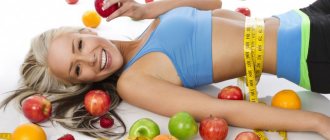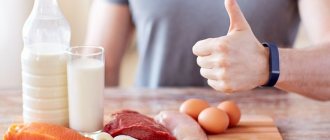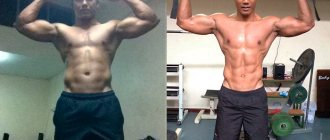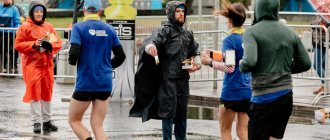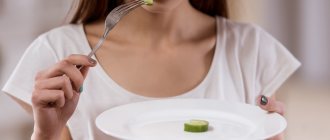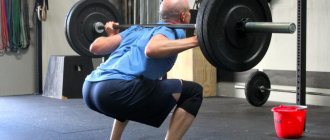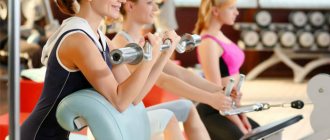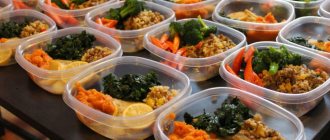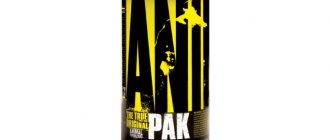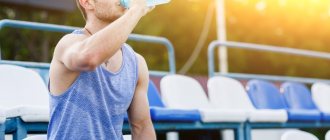Experts:
Stanley A. Herring, MD, W. Ben Kibler, MD, Lexington, Y Margot Putukian, MD, NJ Stephen O_Brien, MD, Rebecca Jaffe, MD, Lori Boyajian-O_Neill, DO, Vincent Disabella, DO, R. Robert Franks, DO, Voorhees, NJ Michele LaBotz, MD
Consultant
— Jacqueline Berning.
Translation
Sergei Strukov.
Sports nutrition
– providing essential nutrients, including fluids, for energy for training, competition, recovery, and health and wellness. The intake and expenditure of these nutrients will be called energy balance. Optimal performance is ensured by adequate energy consumption.
The purpose of this information is to help sports team physicians understand specific nutritional issues in order to advise athletes regarding health and optimal performance.
This is an overview of selected medical issues that are of importance to team physicians responsible for the medical care and treatment of athletes. It is not a standard of care and should not be considered as such. This document is only a guide of a general nature for thoughtful, objective health care practice. Adequate insurance must be in place to protect doctors, athletes and sponsoring organizations.
The recommendations were developed in collaboration with six major specialized sports medicine organizations:
- American Academy of Family Physicians,
- American Academy of Orthopedic Surgeons,
- American College of Sports Medicine,
- American Medical Society for Sports Medicine,
- American Orthopedic Society for Sports Medicine,
- American Osteopathic Academy of Sports Medicine.
Sports Nutrition Basics
Sports Nutrition - Provides essential nutrients, including fluids, to provide energy for training, competition, recovery, and health and wellness. Athletes can meet 100% of their dietary needs with a well-balanced nutrition plan that focuses on performance, hydration, recovery and health. In situations determined by your doctor (such as iron, calcium, and vitamin D deficiency), supplementation may be beneficial.
In this area of sports medicine, sports nutritionists (certified nutritionists - RDs, preferably certified specialists in sports dietetics (CSSD)) should be used to work with athletes. While many offer sports nutrition consultations, an RD meets the minimum educational and training requirements of the Academy of Nutrition and Dietetics, formerly the American Dietetic Association. Only a registered dietitian (RD) can practice as a sports nutritionist (1).
An athlete needs to consume adequate amounts of energy (calories) to maintain or change body weight, health, and maximum training performance (1):
- Inadequate energy intake can lead to muscle loss, increase the likelihood of fatigue, injury and illness, and slow down the recovery process.
- Excessive energy consumption leads to weight gain, which can increase fat content, leading to increased fatigue, risk of injury and poor performance.
- Energy comes from consuming a combination of carbohydrates, proteins and fats.
Carbohydrate (CHO) recommendations for athletes range from 6 to 10 g per kg of body weight per day and can range from 50 to 70% of calories (4, Table 1)
- CHO intake maintains blood glucose (BG) levels during exercise and replenishes muscle glycogen stores.
- A decrease in muscle glycogen levels correlates with the onset of fatigue.
- Glycogen restoration immediately after exercise is important for subsequent optimal performance. Glycogen resynthesis occurs most rapidly in the first 30 minutes. after exercise and lasts more than 6 hours.
- During periods of heavy training, the amount of CHO required may vary depending on the athlete's energy expenditure during the day, the sport and the environment.
Table 1. Recommendations for protein and carbohydrate intake, relative to body weight
| Body weight in pounds (kg) 1kg = 2.2 pounds | CHO consumption level 6-10 g/kg | Protein consumption level 1.2-1.7 g/kg |
| Total daily intake of CHO, g | Total daily protein intake, g | |
| 100 (45,5) | 270 – 450 | 55 – 77 |
| 110 (50) | 297 – 459 | 61 – 85 |
| 140 (63,6) | 378 – 630 | 77 – 108 |
| 150 (68,2) | 405 – 675 | 82 – 116 |
| 160 (72,7) | 432 – 720 | 88 – 123 |
| 190 (86,4) | 513 – 855 | 105 – 146 |
| 220 (100) | 594 – 990 | 121 – 169 |
| 250 (113,6) | 675 – 1125 | 138 – 193 |
Recommendations for protein in strength and endurance sports range from 1.2 to 1.7 g/kg body weight per day and can account for 10–35% of calories (12, 14, Table 1)
- Protein consumption promotes muscle growth and repair. Training increases muscle protein synthesis levels for up to 72 hours after intense exercise.
- Protein requirements are usually met through nutrition; Most athletes consume more protein than they need. There is no need for protein or amino acid supplements.
- With optimal protein intake, body weight is maintained by regulating CHO intake.
Fat intake should account for 20-35% of total energy (7).
- Fats are used as a source of energy. There are essential fatty acids and fat-soluble vitamins that are important for an athlete's nutrition.
- It is recommended to consume one third saturated, one third monounsaturated and one third polyunsaturated fats. Avoid consuming trans fats.
- Consuming less than 20% of energy from fat may have a negative impact on performance.
- Most athletes get more than 35% of their energy from dietary fat; this is undesirable. A high-fat diet can negatively impact performance and health.
Micronutrients are essential for exercise and should be consumed according to dietary recommendations (17).
- Micronutrients play an important role in energy production, hemoglobin synthesis, bone health, immune function, and the production of antioxidants to protect against free radicals.
- Athletes' diets often contain insufficient calcium, vitamins B and D, iron, zinc, magnesium, as well as antioxidants: vitamins C and E, beta carotene and selenium (Table 2)
- Vegetarians may need additional advice regarding micronutrient deficiencies.
Table 2. Sources of nutrients that are often deficient in athletes' diets
| Product group | Vitamins B | Calcium | Vitamin C | Magnesium | Selenium | Vitamin D | Iron |
| Vegetables | Leafy greens, asparagus, cauliflower, sweet potatoes | Broccoli, kale, turnip | Tomatoes, potatoes, broccoli, red peppers | Spinach, romaine lettuce | Green beans, broccoli | Potatoes, spinach | |
| Fruits | Prunes, bananas, orange juice | Fortified orange juice | Citrus and strawberries | Pineapple, bananas | Bananas | Raisins and dried apricots | |
| Cereals | Whole grain bread, cereals, pasta, rice | Corn flour | Whole grains and oats | Spaghetti, rice | Fortified cereals | Oats, Spaghetti enriched grains | |
| Dairy | Milk and low fat yogurt | Milk and low-fat dairy products | Yogurt | Cottage cheese, cheddar | Fortified milk and dairy | ||
| Meat, eggs, nuts, legumes | Turkey, chicken, salmon, tuna, soy | Soya beans | Almonds, cashews, peanuts, baked beans, peas | Nuts, lean meat, chicken, tuna | Tuna, salmon, sardines, soy milk, eggs | Red meat, dark poultry, peas, shrimp |
Fluid intake is necessary to maintain adequate hydration and thermoregulation, and can also be considered as a source of energy (calorie intake).
- Dehydration is defined as a loss of more than 2% of body weight and can negatively affect aerobic performance, impair mental and cognitive function, increase perceived effort, impair balance control, and alter the immune response.
- Hydration is essential to dissipate the heat the body produces, preventing potentially extremely dangerous heat-related illnesses (6).
- Sources of fluids and electrolytes include water and other beverages, as well as some foods.
- The main ingredients of sports drinks are carbohydrates of 6-8% CHO (14-19 g per 240 ml) and 110-165 g sodium per 240 ml (13).
- Fluid/electrolyte balance should be maintained by intake and restoration in accordance with physiological needs, type and duration of activity, and environment.
- For optimal fluid absorption, the carbohydrate content of a sports drink should not exceed 6 - 8% CHO (14 - 19 g per 240 ml)
- Ad libitum fluid intake (optional) may be insufficient to maintain hydration and performance, especially in young athletes; thus, intake can be increased by improving the taste and color of drinks, carbohydrates, and sodium (5).
- Measuring body weight is good for assessing fluid loss (the difference between before and after exercise) and determining the amount needed for recovery. For every kilogram lost, you need to consume 1050-1550 ml of liquid.
Power options taking into account mode and load
If a light exercise regimen is provided, including a daily caloric intake of approximately 3500 kcal, athletes eat as follows:
- morning – 500 g of oatmeal, 4-egg omelette, 2 loaves of bread and an orange;
- 2nd breakfast – nuts, several bananas and yogurt with natural bifidobacteria;
- lunch – 4-6 medium boiled potatoes, 200 g boiled beef tongue, 200 g vegetable salad, juice;
- afternoon snack – boiled brown rice with milk (1 glass), fruits or vegetables – 150 g;
- dinner – 4-6 potatoes, carrot and olive oil salad – 200 g;
- dinner before bed – 250 g of steamed oatmeal, an additional glass of milk.
This menu is perfect for amateur athletes and those who want to maintain an ideal, muscular shape.
Nutrition for athletes on days of intense training:
- 8:00 – 2 eggs, a plate of oatmeal with raisins and toast with nut butter, 250 ml of milk;
- 11:00 – protein bar with carbohydrates;
- 14:00 – chicken broth soup (350 g), 250 g stewed beef, mayonnaise vegetable salad;
- 16:00 – sports protein shake;
- 19:00 – 300 g of steamed buckwheat, 150 g of red fish, baked in the oven, tea;
- 21:00 – 200 g of oatmeal or 200 ml of milk.
Another option takes into account the diet before the competition:
- first dose – a mug of milk, 0.5 kg of buckwheat and baked goods (bread or bun with raisins);
- second meal – coffee, half a bar of dark natural chocolate, banana, meat sandwich;
- lunch (third meal) – 0.5 kg of chicken soup, tuna or trout, 0.5 kg of rice, compote with oatmeal bread;
- fourth snack – 250 ml of freshly squeezed juice and baked goods;
- fifth – green tea and stewed chicken (approximately 160-200 g);
- before bed (two hours before) - bran bread, pear with oatmeal.
Sports nutrition for every day should be prepared taking into account the specifics and nutritional capabilities (time) of athletes. That is, the above hours are approximate for the athlete. It is necessary to select the hours of eating, taking into account the peculiarities of the daily routine: training time and work.
For strength bodybuilders and ordinary people who love sports and a beautiful figure, a diet that should remain varied is of great importance.
Below is a table of the correct foods of animal and plant origin, according to calorie content.
Warnings
- Misinformation and myths about sports nutrition are widespread and come from popular but untrustworthy sources.
- Some athletes may experience stomach upset when trying to follow fluid and nutritional guidelines correctly. Resistance can be increased by increasing the rate of gastric emptying through the following steps:
- Use small, frequent meals and liquids instead of large ones.
- Use liquids with low CHO content (6-8%) instead of more concentrated drinks.
- Cool liquid leaves the stomach faster than cold liquid
- Some athletes will have difficulty ingesting fructose and will need to use glucose or sucrose based carbohydrates.
- When making dietary changes, be clear about timing and implementation.
- As training loads increase, athletes may believe that they need additional sources of protein. Increasing your balanced caloric intake will provide the required amount of protein. A common mistake is using protein supplements to compensate for a calorie deficit.
- Only those who have completed RD registration and received a CSSD can practice as an athlete nutritionist.
What are the consequences of skipping breakfast?
The cause of global obesity, according to scientists, is neglect of eating in the morning. People who don't eat breakfast gain 3-5 kg annually. This is not so noticeable at an early age and adolescence, but over the years it makes itself felt. From 35 to 50 years of age, the habit of not having breakfast in the morning leads to obesity and its characteristic health problems.
Skipping breakfast can cause the following consequences:
- The risk of heart attack and death from coronary disease in men increases by 25%;
- By the age of 40, the degree of excess weight in women can range from 5 to 20 kg;
- The risk of developing cholelithiasis and type II diabetes mellitus increases for both sexes;
- Both men and women experience a decrease in labor activity and the ability to think logically.
Meals in the off-season
The off-season in this document refers to the period when the athlete does not compete, but trains for this purpose. The general nutritional principles for food and fluid intake remain similar and are consistent with training goals for this period. The most important factors when training in the off-season:
- Energy requirements may increase or decrease depending on your training activity.
- A well-balanced diet does not require the consumption of protein or amino acid supplements, even during training aimed at increasing muscle strength and mass.
- Energy intake changes to gain or lose weight.
What not to eat
You can't eat regular table salt, eat sea salt instead. The following should not be included in your daily diet:
- Canned foods;
- Sausages, frankfurters, small sausages;
- Industrially processed products;
- Alcohol;
- Spicy and fried foods;
- Sugar and sugar-containing products (yogurt, cheese, full-fat cottage cheese; lemonades, juices, baked goods);
- Fast food;
- Crackers, chips, sweet lemonades;
- Semi-finished products, juices from powder;
- Mayonnaise, ketchup, sour cream, fatty sauces.
Nutrition during the competition season
The competitive season here refers to the period during which sports competitions are held. The general nutritional principles for food and fluid intake remain similar and are consistent with training goals for this period. The most important factors when training during the competitive period:
- Distribution of liquid and food intake
- Increasing CHO intake relative to protein and fat
- Increased control over the intake and restoration of fluids and electrolytes.
- Maintaining Energy Balance
- Calorie expenditure often exceeds intake throughout the competition season
- Adequate energy balance keeps proteins from being used as an energy source and prevents loss of lean body mass.
Time of consumption of liquids and food
- Spreading your caloric intake over time to maintain lean body mass and reduce fat.
- Maintaining Hydration
- Use the “recovery window” (see section).
The team doctor needs to know the following:
- Nutrition and energy balance play a vital role for optimal performance.
- The role of nutrients is great: CHO, proteins, fats and micronutrients.
- The athlete must ensure his training and competitive activities through a balanced diet without the use of nutritional supplements, excluding certain medical conditions.
- For optimal performance, it is necessary to adhere to the energy distribution and daily routine.
- Depending on the activity, it is necessary to make nutritional adjustments.
- Fluids are important for hydration, thermoregulation and energy supply.
It is advisable for the team physician to do the following:
- Understood the importance and qualifications of a sports nutritionist (RD, CSSD)
- Coordinated efforts in the medical support of sports activities, including a sports nutritionist who should teach nutrition and conduct individual consultations on the issue with athletes.
- Counsel athletes regarding the importance of fluids and nutrition for optimal training, recovery, and athletic performance.
- Consider fatigue and performance issues as possible manifestations of poor nutrition.
- Knew the proportions of CHO, proteins, fats and micronutrients in the diet.
Table 3. Strategies for increasing or decreasing body weight
| Strategy | Type of products |
| Weight gain Examples of food choices that provide more calories and carbohydrates, which are necessary for weight gain and maintaining a balanced and adequate diet |
|
| Foods high in carbohydrates/calories that help increase energy intake |
|
| When an athlete has difficulty consuming large amounts of food, he can try the following: |
|
| The athlete's diet is balanced, but simply excessive. Even low-calorie foods can cause weight gain when food portions are too large. Monitor and evaluate portion size using the following techniques: |
|
What foods are not recommended for breakfast?
Not every breakfast is healthy. The choice of products for the morning menu must be approached thoroughly. Sandwiches with coffee and tea are not the best replacement for fruit salads and cereals. They and other traditionally eaten breakfast foods provide virtually no benefit.
There are a number of foods that are not recommended for breakfast by nutritionists. These include:
- Sausage, sausages, bacon.
These meat products contain large amounts of nitrates, salt and other chemicals. Experts advise replacing them with chicken or turkey meat.
- Breakfast cereals.
Ready-made breakfasts contain not only plant fiber, but also abound in “fast” carbohydrates - sugar. The feeling of fullness after a dry breakfast is quickly replaced by hunger. To avoid this, you should eat whole grains, for example, muesli filled with kefir with nuts and fruits.
- Donuts and pancakes.
The fast carbohydrates contained in these products contribute to the formation of fat deposits from excess sugar and are not good for your figure. When they are consumed, heaviness appears in the stomach.
- Yogurts from the store.
The yoghurts presented on supermarket shelves contain preservatives, sweeteners, and flavorings. It is recommended to prepare fermented milk products for the morning meal yourself. If this is not possible, yogurt should be replaced with kefir.
- Cottage cheese.
This healthy and protein-rich product is not suitable for breakfast. It is recommended to eat it not in the morning, but in the afternoon.
- Citrus.
Tangerines and oranges consumed on an empty stomach can provoke allergies and lead to the development of gastritis.
- Bananas.
If you eat bananas containing excess magnesium in the morning, this can disrupt the internal balance of the body. Bananas should not be consumed for breakfast, but in the afternoon.
- Canned foods, smoked meats.
- Sweets and tea with sugar.
The calorie content and nutritional value of the morning meal are selected individually. Carbohydrate-rich and light breakfasts are necessary for people with intellectual work; protein-rich and high-calorie breakfasts are recommended for those who do physical work.
Nutrition and body weight changes
Managing an athlete's body weight can help optimize athletic performance and health (Tables 3 and 4). This program is the best means of monitoring health through the regulation of sports nutrition. Regulatory goals must be realistic and take into account many parameters: gender, type of sport, medical history, dynamics of changes in body weight and psyche. Body weight changes should be made during the off-season (15). Additional factors to consider when gaining or losing weight:
- Physical maturity of the athlete
- Increase in lean mass or decrease in fat mass
- Current weight and body composition
- Diet and habitual physical activity (eg, analysis of 3-day food and activity records) to determine energy intake and expenditure
- Frequency of monitoring the athlete's performance (weight/composition assessment at the beginning and every 1 - 2 weeks)
- It is useful to periodically evaluate the athlete's nutrition
- Improvements in body weight management should ideally occur primarily in changes in body composition rather than in weight.
Table 4. Food replacement table for reducing calories
| Instead of this | try it | Calorie difference |
| Cup of 2% milk (120) | Cup of skim milk (80) | 40 |
| Tuna in oil (170) | Tuna in its own juice (100) | 70 |
| Morning fast food sandwich (300) | English muffin (150) | 150 |
| Double hamburger (560) | Grilled chicken sandwich (400) | 160 |
| Caesar Salad (520) | Homemade salad (300) | 220 |
| Fast food fried chicken (400) | Grilled chicken breasts (170) | 230 |
| 6" Meatball (540) | 6" Turkey Cue Ball (280) | 260 |
| 475 ml coffee with caramel (430) | 475ml nonfat latte (160) | 270 |
| Taco Salad (790) | Cheese quesadilla (490) | 300 |
| Extra Large French Fries (610) | Small French fries (210) | 400 |
| Fast food shake (900) | Small Vanilla Cone (150) | 750 |
Menu during the drying and fat burning period
Proper nutrition for a healthy, muscular athlete sometimes requires adjustments that are designed to “dry” muscle mass, that is, burn fat. This is necessary for “drawing” muscle relief by getting rid of excess fat deposits.
Below is a balanced diet for male athletes (reference: body weight 90 kg, height 182 cm):
Day 1. Food norm.
- chicken and potatoes - 200 g each, salad of one tomato and cabbage leaf;
- low-fat cottage cheese – 200 g, orange and banana;
- fish and rice - 250 g each, sweet pepper and 3 leaves of white cabbage;
- potatoes and veal - 150 g each, 5 boiled eggs (without yolks), a couple of leaves of Chinese cabbage;
- chicken breast – 150 g, boiled rice – 60 g, 3 lettuce leaves, tomato, pepper;
- 200 ml orange juice and 200 g chicken.
Days 2 and 3. Carbohydrate reduction period.
- steamed fish - 200 g, salad of 100 g white cabbage and one tomato;
- 7 boiled eggs without yolks and 2 tangerines;
- 200 g boiled breast, a couple of lemon slices, parsley, zucchini - 150 g;
- 7 boiled proteins and 2 grapefruits;
- 200 g of sea fish, tomato and white cabbage;
- fish salad: 2 cans of tuna, 1 tsp. olive oil, green onions, tomato, vegetable bread, lettuce.
Day 4. Increase carbohydrates.
- chicken salad: boiled protein, potatoes (100 g), Chinese cabbage (3-5 sheets), pepper, cucumber, chicken (100 g);
- cottage cheese and kefir - 200 g each, 5 tangerines;
- steamed potatoes and chicken - 150 g each, lettuce, tomato, pepper, a couple of soft-boiled eggs;
- fruit salads: kiwi, orange, tangerine, 1/3 apple and grapefruit, 10 grapes and the kernel of any nut, preferably a walnut.
Day five repeats the norm of usual products for athletes, that is, day one and so on.
Sports menu for the week for the fair sex (weight approximately 60 kg, height 168 cm).
The first day:
- boiled rice and fish – 50 g each, half an orange;
- protein omelet (from 2 eggs), 100 ml milk;
- steamed buckwheat and lean meat (fillet) - 60 g each, tomato and three olives;
- low-fat cottage cheese - 120 g, banana and half an orange.
Days two and three:
- omelette of three eggs (two whole and one white), 100 ml of milk;
- veal – 60 g, sweet pepper and lettuce, green onions and parsley;
- 150 g cabbage (broccoli or cauliflower), boiled fish - 100 g, lemon wedge;
- low-fat cottage cheese – 80 g.
Day four:
- oatmeal with raisins and dried apricots – 50 g;
- three proteins, brown or wild rice - 30 g, half an orange;
- chicken broth – 70 ml, 30 g buckwheat, tomato and three olives;
- 125 g homemade yoghurt.
Similar to the men's cutting diet, the fifth day repeats the first, the sixth day repeats the second day, and so on.
For effective results, the above diet should be maintained for a month. At the same time, you should not lose sight of your usual sports activities.
The menus given are tailored to a specific body weight. To create a personal diet, it is necessary to take into account the following parameters: gender, body weight, body constitution, previously consumed amount of calories, daily activity (work, number of daily workouts).
Principles of weight gain
- When energy intake exceeds expenditure (positive energy balance), weight gain occurs.
- Athletes looking to gain weight should increase their energy intake so that they add lean mass rather than fat.
- During weight gain, protein intake should be at the upper recommended level (Table 1).
- Lean mass gains provide an additional 500–1000 kcal/day over the course of an appropriate strength training program. If these conditions are met separately, then the dry mass does not increase. Weight gain exceeding 900 - 1400g per week is not due to lean mass.
- Focusing on strength training rather than aerobic exercise stimulates muscle growth.
- Proper hydration must be maintained at all times.
- Avoid skipping meals to optimize the timing of energy intake.
Warnings
- A significant increase in body fat has a negative impact on the immune system and increases the risk of chronic diseases.
- Athletes who are increasing their muscle and body mass often use nutritional supplements to accelerate their weight gain. The only safe and effective way to increase muscle strength and size for long-term improvements in athletic performance is to increase muscle load in combination with recommended energy and protein intakes.
Why don't you want to have breakfast in the morning?
Lack of appetite in the morning is often accompanied by a feeling that the stomach is full. My health also leaves much to be desired. Apathy, drowsiness and fatigue are the result of low blood sugar levels in the morning. All this is caused not by the individual characteristics of the body, but by the lack of proper nutrition and proper rest.
Eating food before bed does not allow the digestive tract to rest. To digest the food eaten, the stomach does not stop working at night. This entails a feeling of morning satiety. Such a eating habit is a violation of the basics of a proper diet and entails negative consequences for health.
Overeating at night is largely due to the existing misconception that the energy accumulated at dinner is stored and spent the next morning, and breakfast contributes to excess weight gain. Everything happens the other way around. Food eaten before bed turns into fat deposits, and breakfast is perfectly absorbed by the body and gives the necessary boost of energy. And to regain your appetite in the morning, you need to reconsider your eating habits.
Principles of weight loss
- When energy expenditure exceeds energy intake (negative energy balance), a decrease in body weight occurs.
- Athletes looking to lose weight should target their intake to maintain muscle mass and reduce fat.
- Increasing energy expenditure and moderately reducing intake may protect against loss of strength and muscle mass during dieting.
- Weight loss should be gradual, approximately 250 – 900 g per week, which is equivalent to an energy deficit of 250 – 1000 kcal per day.
- Female athletes should not consume less than 1200 - 1400 kcal per day, male athletes should not consume less than 1500 - 1700 kcal per day. Athletes will not be able to maintain adequate micronutrient intake with such limited energy intake.
- Athletes need to drink enough when losing weight.
- You should not skip meals to prevent compensatory overeating.
- Aerobic exercise is preferred to create a negative energy balance, while resistance training will help prevent muscle loss.
Warnings
- Athletes, especially in sports with weight restrictions, may feel pressure to achieve low mass or unrealistic body composition. Such pressure leads to disordered eating and eating disorders.
- Negative energy balance leads to weight loss and endocrine disruption (11).
- These conditions present an extremely difficult situation for any professional guiding the weight loss process of athletes.
- Weight loss can impair performance by affecting energy reserves, weakening immune function, changes in behavior, enzyme activity, and structural changes in muscle.
- Rapid and excessive weight loss can have negative health effects, including cognitive dysfunction, cardiac dysfunction, and inability to maintain body temperature.
- To reduce the risk of injury, athletes should eat and drink properly before training and competition.
- Low-calorie diets and weight loss pills should be avoided.
- Recommendations for regulating body weight should be given by specialists with knowledge in the field of sports nutrition.
It is essential that the team physician knows the following:
- Changes in energy balance are key to weight management.
- Weight management can be achieved through dietary changes and exercise alone.
- Excessive or insufficient energy consumption can negatively affect health.
It is advisable for the team physician to do the following:
- Determined the necessary goals and methods for changing body weight.
- Consulted athletes regarding weight management products and fluids.
- Coordinated the efforts of staff involved in athlete weight management, including consultations and sports nutritionist work.
- Recognize warning signs of negative energy balance (eg, fatigue, decreased fitness, frequent illness and injury, eating disorders, and endocrine dysfunction).
- Was aware of the possible negative consequences of micronutrient deficiencies caused by negative energy balance.
- Dispelled myths associated with fad diets, low-calorie diets, and weight loss medications.
Recommendations from professionals
On the topic of “Nutrition for Athletes,” many fitness trainers quite often argue and establish their own personal and acceptable principles of nutrition. However, there are generally accepted recommendations that any bodybuilding coach will tell you:
- Each athlete must have a personal menu. The diet should be compiled based on weight, age category, gender, training time and load.
- Regardless of individual characteristics, nutritional principles should be maintained in the ratios BZHU: 30-10-60%.
- Athletes' nutrition should include nutritious, natural food, without chemical additives.
- You shouldn't overeat, but you shouldn't feel hungry either. You need to eat slowly, chewing well.
- Cereals should be consumed not in light, but in dark shades. For example, it could be buckwheat or brown rice.
- It is necessary to increase strength and endurance through natural carbohydrates and gainers. Drinking chemical energy juices is strictly prohibited.
- Use sports supplements with caution, knowing when, how and why.
- In moments of “drying”, losing extra pounds, it is necessary to spend more calories obtained from food. Optimal weight loss should be approximately 500 to 1000 g over 7 days. It is worth remembering that losing weight is stress for the body, which needs to be relieved with vitamins and beneficial minerals.
Nutrition before exercise
Exercise – purposeful training or competition potentially related to the demands of the sport. Pre-workout period is the period of time before exercise, ≤4 hours before the start of training. General and special nutritional and fluid requirements are determined before the start of the competition season. Eating adequately before exercise can improve performance compared to fasting (10). Pre-workout food and fluids should consist primarily of carbohydrates to maintain BG during exercise, which helps reduce muscle and liver glycogen consumption; moderate amount of protein; and low in fat and fiber to minimize gastrointestinal distress (1).
Pre-workout nutrition is individualized based on differences in needs. The optimal (theoretically) appointment time is not always justified, taking into account schedules or individual preferences. Athletes need to experiment with fluid and food choices and timing of consumption before exercise before implementing a strategy during competition.
It is important to maintain fluid and food intake timing when considering pre-workout nutrition.
- Liquids
- At least 4 hours before exercise, drink 350–600 ml of water or sports drink (6–8% CHO, Table 5). This will optimize hydration and allow adequate time for excess fluid to be eliminated.
You can drink some liquid before starting the exercise.
- Food
- CHO: 3-4g CHO per kg body weight 3 – 4 hours before exercise; can be in solid form.
- CHO: 1g CHO per kg body weight one hour or less before exercise; only liquid.
Warnings
- Determine the amount of CHO in the liquid. Concentrations above 6-8% CHO may reduce fluid absorption.
- The concentration of CHO in most “energy drinks” exceeds 8%.
- Enough calories are needed so that the athlete does not feel hungry during exercise, but not so much that undigested food remains in the stomach.
- Avoid consuming large amounts of fiber and fat before exercise, as this may cause gastrointestinal distress before and during exercise.
Table 5. Examples of foods to consume before class
| At least 4 hours before exercise, drink 350-600 ml of water or sports drink (6-8% CHO or 14-16 g CHO and 110-165 mg sodium per 240 ml) | |
| Three to four hours before competition or training, the athlete should take |
|
| One hour before training or competition |
|
Cooking features
Any healthy product can be ruined by improper preparation. The easiest way to cook rice is in bags - it makes a crumbly porridge. It is recommended to pre-soak its other types in cold water, possibly overnight. This is especially important for unpolished varieties, as they take a long time to prepare.
After soaking, this cereal will be ready in 20-25 minutes. It is recommended not to wait until the water is completely absorbed; as soon as the grains become soft, you need to drain it in a colander. Long grain rice turns out fluffy, it is well suited for salads, pilaf, and a side dish for meat. Round-grain varieties become viscous when cooked, so it is better to prepare porridges, casseroles or puddings from them.
To increase the beneficial properties of rice, you can cook it with vegetables. It’s better not to add salt. It can be replaced with dried garlic or other spices.
Nutrition during exercise
With prolonged exercise, the body's energy reserves are depleted, the feeling of thirst may become dull, and the rate of gastric emptying decreases. However, athletes need to consume fluids and nutrients for optimal performance. When the body's glycogen stores are depleted, muscles rely more on blood glucose for fuel, especially after 2-4 hours of continuous exercise. In addition, adequate fluid and electrolyte replacement is essential for normal cardiac function, thermoregulation, optimal performance and recovery, and helps prevent muscle cramps and electrolyte imbalances. An individualized plan is necessary to prevent overhydration, dehydration, and/or electrolyte imbalances.
- Fluid replacement should occur as early as possible during exercise and continuously during activity.
- For exercise lasting less than an hour, water or sports drinks are sufficient.
- Consumption of sports drinks is recommended when exercising for more than 1 hour.
- CHO in drinks is especially necessary when exercise is performed on an empty stomach after sleep or liver glycogen stores are low.
- Consuming 30–60 g of CHO per hour can increase the duration of long-term endurance exercise (3).
- Take 180 – 360 ml of sports drinks every 15 – 30 minutes. performing exercises increases the duration of effective performance of loads in athletes during continuous or interval work.
- Replenishing fluids with water alone can lead to hyponatremia. Athletes should avoid drinking too much water and drinking much more water than they lost during exercise. The drink should contain at least 100 mg sodium per 240 ml to prevent hyponatremia.
- Fluid and electrolyte losses vary depending on the sport, different people, and different environmental conditions. Athletes need to anticipate losses and adhere to recommendations regarding fluid intake.
- Potassium is essential for fluid and electrolyte balance. A diet rich in fresh fruits, nuts, seeds, dairy products, lean meats, and unprocessed grains is generally considered adequate to maintain normal potassium levels in athletes.
Warnings
- Athletes should not begin exercise when their energy reserves are depleted or when they are dehydrated.
- There is no need to consume protein or potassium when performing exercise to increase performance.
- CHO in solid form can also be consumed during exercise, but will be absorbed more slowly than liquid and gel forms. In certain sports (cycling racing) you can consume carbohydrates in solid form, while in swimming or running it is more convenient to use liquid forms.
- Hyperhydration fluids (eg, glycerol) do not improve performance or hydration and are not recommended for use.
Products for an athlete's diet
The main thing to consider is that food for an athlete must perform a number of specific tasks, and is not solely a source of satisfying hunger. Products on a bodybuilder’s menu must meet the following requirements:
- Supply the body with all necessary nutrients, micro- and macroelements, vitamins, calories
Caloric value directly depends on the athlete’s sporting goals.
- Contribute to the normalization and activation of metabolic processes occurring in the body
This quality is fully met by natural additives and active biological substances.
- Regulate body weight
Weight depends on your goals. At some stages of training, the mass should decrease, at others it should increase, and in some cases it should be maintained in an unchanged state.
- Change morphological parameters
This property allows you to build muscle mass, and, on the contrary, reduce body fat.
Nutrition for recovery after exercise
At the end of exercise, there may be a deficiency of energy (primarily muscle and liver glycogen depletion) and fluid (water and electrolytes). Muscle damage may also occur, requiring proteins to repair. The goals of post-exercise nutrition are to provide adequate amounts of CHO, fluids, and electrolytes for muscle glycogen replenishment, overall recovery, and hydration. Consuming protein after exercise provides the body with amino acids to build and repair muscle tissue.
It is necessary to compensate for the deficiency for optimal performance at the next load. The method that will be used for recovery is selected based on the time until the next competition/training. This is especially important for athletes who have several classes a day or training the next day.
The optimal time for carrying out recovery measures is the first 6 hours after the end of the exercises. The greatest recovery of glycogen is observed in the first 30 minutes.
- Consuming 1.0-1.5 g of CHO per kilogram of body weight in the first 30 minutes after exercise increases glycogen stores and reduces recovery time (muscle strength) compared to consumption 2 hours after exercise (8).
- High glycemic index CHOs (simple CHOs) restore glycogen faster than low glycemic index CHOs (complex CHOs) (2, see Table 6).
- Adding 10 to 20 grams of protein to your post-exercise meal does not increase glycogen stores, but may have a positive effect on muscle recovery and growth. For recovery, it is important to consume proteins and carbohydrates together. Adding 10–20 g of protein after exercise facilitates the onset of protein synthesis (9).
Table 6. Glycemic index of food
| Low Glycemic Index Foods/Drinks (<55) | High glycemic index Foods/drinks (>70) |
| Skimmed milk | Sports drinks |
| Yogurt | Potato |
| A pineapple | White bread |
| Bananas | White rice |
| Beans | Cornflakes |
| Sweet potato | Honey |
Continuing recovery activities after 30 minutes, over the next two hours the athlete should consume 1.0 - 1.5 g of CHO per kg of body weight and 10 - 20 g of protein (see Table 7).
Table 7. Food for recovery
| For example, an athlete weighing 68 kg needs to start by taking 68 g of CHO for recovery and 10 - 20 g of protein in the first 30 minutes after finishing exercise: |
|
| Within two hours after training, food intake consists of: |
|
For optimal recovery, fluid replacement is combined with glycogen replenishment.
- The volume of liquid for recovery should be 1.5 times higher than the loss. The simple recommendation of drinking 1.1 - 1.6 liters for every kilogram of body weight lost helps athletes replace fluids after exercise.
- Thirst is a poor indicator of fluid requirements: 1.5 liters of fluid must be lost before thirst occurs.
- Adding electrolytes speeds up recovery; Individual fluid balance can be restored three times faster with a sports drink compared to water. Consuming rehydration drinks and salty foods helps replenish lost fluids and electrolytes.
- Water combined with food is a good replenishment strategy when food is available. The concentration of electrolytes in foods is higher than in electrolyte drinks.
- There are significant differences in individual levels of sweating and electrolyte loss depending on environmental conditions, adequacy of acclimatization, or individual characteristics.
- With large losses of electrolytes (“salty sweat”), additional sodium restoration may be necessary.
- Replacement should be completed approximately 0.5 - 1 hour before the next competition to establish homeostasis.
Warnings
- All athletes need to restore energy, but for those whose next training session is a few days away, there is no need for urgent recovery measures.
- Athletes often begin exercise with incomplete energy and fluid restoration.
- Athletes should avoid consuming large amounts of protein instead of CHO.
- There is no advantage to intravenous fluid replacement over oral fluid replacement as long as the athlete can drink a similar amount.
Mandatory for the team doctor
- Recognize the importance of planning fluid and energy intake before, during, and after exercise.
- Understand the need to distribute the time and composition of fluid and energy recovery before, during and after exercise.
- Know individual differences among athletes.
Preferably for team doctor
- Coordinate with training staff the plan for fluid and food intake before, during and after training.
- Counsel athletes regarding fluid and nutritional intake plans.
- Draw the attention of athletes to the increased risk of energy and especially fluid deficiency, especially those who sweat heavily and lose large amounts of sodium.
- Understand the value of body weight measurement as a guide to fluid intake.
Carbohydrate and protein breakfasts
Carbohydrate-rich breakfast foods are recommended for knowledge workers. The ideal carbohydrate breakfast option is cereal porridge or muesli cooked in water. The menu can be diversified by adding nuts, fruits and natural juices to the muesli. Butter products and sweets are also rich in carbohydrates, but they are harmful to your figure. Cereals, on the contrary, help stabilize and maintain weight. You need to choose foods that contain carbohydrates so that the feeling of fullness is not accompanied by the desire to take a nap.
Proteins for breakfast are necessary for athletes who move actively during the working day or people engaged in heavy physical activity. A classic English breakfast is an excellent source of protein. You don't have to stick with the traditional omelet. It can be varied with prepared vegetables and chicken. There is no need to give up carbohydrates completely. A small piece of whole grain bread and a slice of cheese will provide the carbohydrates required for full physical activity.
Denis Semenikhin. Sports breakfast to go
Taking nutritional supplements
Taking supplements is outside the scope of these recommendations.
- Athletes can meet 100% of their nutritional needs with a well-balanced nutrition plan that focuses on performance, hydration, recovery and health. In circumstances determined by your doctor, taking supplements may be beneficial (for example, iron, calcium, and vitamin D deficiencies).
- Although all manufacturers are subject to testing by the U.S. Department of Health and Human Services (FDA) to ensure the identification, purity and presence of all ingredients contained in a product, they are not required to demonstrate that the products are safe and effective.
- The addition of prohibited substances to dietary supplements remains a concern (16).
Sports medicine practitioners should consider the following factors when evaluating nutritional supplements:
- The validity of (manufacturer's) claims in terms of evidence-based nutrition and exercise science.
- Possible health hazard.
Source:
How is breakfast good for the body?
Morning hours are the best time to get energy reserves for the whole day. Its deficiency can be compensated for by later meals, but they will not be able to normalize metabolism. Giving up breakfast for the purpose of losing weight or maintaining weight is pointless. This will have the opposite effect. Carbohydrate-rich and high-energy foods are absorbed better in the morning, helping to reduce appetite and maintain a feeling of fullness for a long time.
Morning meals have a beneficial effect on well-being and health:
- accelerate the metabolic process by an average of 5%;
- normalize cholesterol levels;
- prevent platelet aggregation (sticking together);
- reduce the risks of strokes and heart attacks.
People who do not skip breakfast are significantly less likely to suffer from diabetes, high blood pressure, and gallstones.
Eating in the morning gives a boost of energy and vigor, relieves drowsiness and apathy, and lifts your spirits. Breakfast stimulates a person’s intellectual abilities, increases attentiveness and concentration.
Menu for athletes
An example of a balanced menu includes the following products:
- 400 grams of poultry meat;
- 0.4 kg cottage cheese;
- 30 grams of butter;
- 200 grams of bread;
- 0.5 kg cereal porridge;
- 300 grams of fruits and vegetables;
- 4-5 pieces of eggs.
For a strength athlete
If the ultimate goal of training is to gain muscle mass, the athlete needs a lot of protein. Some athletes prefer to receive it along with the food they eat, others - in the form of specially formulated supplements. The latter include gainers, amino acids, and proteins for preparing protein nutritional cocktails.
For girls
Nutrition for athletes actively training in the gym has its own characteristics. In addition to complex carbohydrates, it should be dominated by vegetable fiber and monounsaturated fats. It is preferable to eat small meals. The break between individual meals should be less than three hours.
Sample menu for girls actively involved in sports:
- The first breakfast includes three eggs, oatmeal (100 g), and the second - half a liter of kefir or milk;
- For lunch, it is recommended to eat brown rice (150 g), white poultry or fish (200 g);
- For an afternoon snack, nuts and cottage cheese (200 g) are best;
- For dinner they serve salad or fruit, meat or fish (200 gr.);
- Before going to bed, it is recommended to drink at least 500 ml of kefir, which can be replaced with any other fermented milk product.
The dietary requirements for an athlete remain the same, regardless of how long the menu is drawn up - for a week or a month. The main thing is that the products in it are chosen exclusively nutritious, natural and healthy.
Prohibited Products
Regular table salt is a taboo for athletes. An alternative to it is sea. It is rich in many useful elements. The menu should not include spicy or fried foods, mushrooms, sugar, alcoholic beverages, various types of semi-finished products, or juices made from powder.
